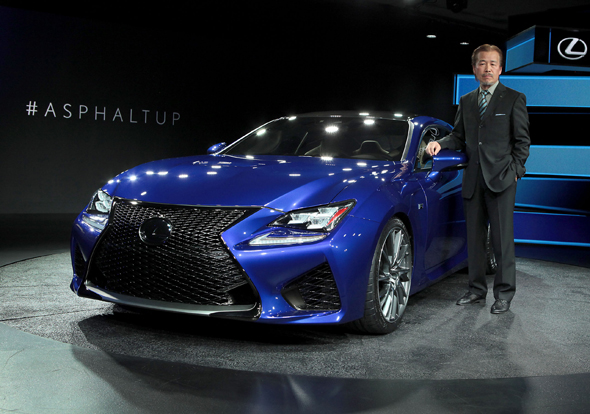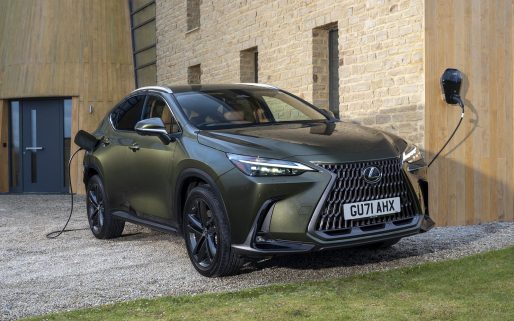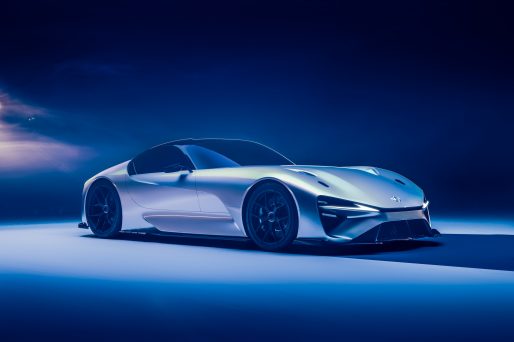“This is the most exciting sports car in our range”, says Lexus chief engineer Yukihiko Yaguchi, describing the new Lexus RC F at its launch at the 2014 Geneva motor show.
First revealed at the Detroit motor show in January, the Lexus RC F has now made its European debut alongside a new racing GT3 version. It’s powered by a revolutionary 5.0-litre, 32-valve V8 engine – which with more than 450bhp, will make it one of the most powerful cars in its class.
For the engineers among you, the new engine uses both the Otto and Atkinson ignition cycles to deliver improved performance and efficiency, offering an advanced variable valve timing (VVT) system to manage its fuel consumption and power output. The two-door Lexus RC F is set to take the fight to the BMW M4 and Mercedes-Benz C63 AMG. Here’s Yaguchi-san’s take on the upcoming battle, in his own words…
Damion Smy: Why a V8 powerplant when BMW, for instance, has decided to fit a turbocharged six-cylinder?
Yukihiko Yaguchi: “First of all, the V8 engine format is the most appropriate for a sports car engine. The reason is that when we talk about sport driving, the torque feel – the acceleration – is most important, and that’s what the V8 format gives. This can also be said for the V10 in the LFA, but if you put under load the torque characteristic [of the V10] is very smooth, but as you go under load it [the V8] gives almost a heartbeat feeling.”
DS: How have you managed to avoid turbocharging – or is that a deliberate point of difference for the RC F?
YY: “For the ‘F’ brand, the powerplant – the engine – is an important identity, so for this reason we would keep a specifically designed engine. We’ve managed to incorporate detailed electronic control on the intake side of VVT, so at maximum, we are able to finely control the amount of air reaching the engine. What that means is in actual terms is better efficiency. By adjusting the valve opening, we can change the engine’s performance – making it run like an Atkinson cycle engine. This gives you an equivalent downsizing of 800cc, and the efficiency of a 4.2-litre engine. Of course, when you go to a wide-open throttle, you get the Otto cycle so get maximum power, [and] being naturally aspirated, you get a really high responsiveness.
DS: So a turbo doesn’t offer the driving character you wanted?
YY: “If you look at a turbocharged engine, if you look at its torque characteristics, as you get into higher revs it has a slightly flat character. Whereas, what we’re looking for is a synchronisation of the engine’s speed to the torque feel you get, and this is what you can achieve with a naturally aspirated engine – that heightened sense of torque as you go into the higher revs. This is what we wanted. Having said that, if we can find a turbo that offers use the same, then we have a choice to go turbo….”
DS: Would sequential twin-turbos have offered a similar solution while meeting the new “Euro 6” exhaust emissions laws?
YY: “If you look at a typical engine room that has a twin or even a triple turbo, the structure itself becomes quite complex, and you would have to think about the intercooler… so it’s hard to find packaging space. And other manufacturers are facing the same issue [meeting Euro 6, while developing adequate performance and drivability], so you can see them going from perhaps eight-cylinders to six-cylinders, or if they’re doing a V8, then swapping of intake and exhausts just to make room for that.”
DS: How hard was it to meet new emissions legislation with the new V8?
YY: “It was indeed very difficult; because Euro 6 is a very stringent restriction. Might I add that the [V8 engine in the] IS F at the time met Euro 5 regulation, so you can think of it as an evolution. Some of the items – we talked about increasing the power using the electronic VVT (variable valve timing) – those kind of things that we were able to go into finer calibration… and the D4S [direct injection] system has evolved.”
DS: What are your future plans for turbocharged engines
YY: “If we talk about turbos and such technologies – this is something that in the future we don’t think we can avoid, and we will be investigating – perhaps at the time of a new platform introduction.
“If there is an optimal time, we might go from having many cylinders to having a turbo.”
DS: What about a dual-clutch transmission? Would that help CO2 as well?
YY: “I don’t think it would contribute to a lower CO2. If you have a look at the automatic gearboxes of today, after second gear, they’re in full-lock up, so there’s no difference. Also, in the low gears we have the torque convertor that’s very smooth, and this is something that we believe will be more important, as even in Europe, traffic jams are increasing…”
DS: How important is the RC F to the Lexus brand?
YY: “I think this car is showing the direction for us. The GT3 is highlighting the potential for participation in motorsports, while the RC F is showing the emotional styling aspect that we would like to reach out with for the Lexus brand, so you can see this more emotional styling coming through, and hopefully that will give emotional value to the Lexus line-up.”





Did you consider cylinder deactivation?
Hi Matt
Thanks for your post.
We may know more about the finer spec details nearer the launch, we have used cylinder deactivation in the past (Lexus LFA). However for the RC F they are using the Atkinson cycle at cruising speeds for enhanced fuel economy, it then switches to the Otto cycle at higher revs to generate high performance.
Thanks David, never knew they used it in the LFA! Just wonder if it may be possible in the future to combine both technologies, a 5L V8 that can switch in a millisecond to a 2.2L V4 on the atkinson cycle would be amazing!
Hello Matt
Thanks for your reply and feedback.
They did indeed use on LFA and it can run on five cylinders when idling (you probably know its a V10). You even get a message on the dashboard to tell you when the car is doing this. Keep an eye on our Blog for future articles on RC F because we will be publishing plenty more over the coming months.
“If you have a look at the automatic gearboxes of today, after second gear, they’re in full-lock up…”
Was there a translation error? Did he mean after FIRST gear, which would mean gears two through eight? I always believed that full lock up occurred for gears two through eight, not three through eight.
Hello,
Gear two lock up is controlled to suite drive condition. It is mainly used for engine braking rather than economy, like the higher gears.
We do hope this helps, many thanks.